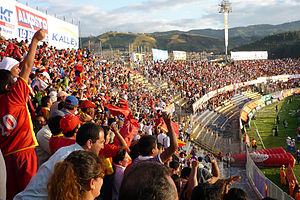Pasto, Colombia
Partly due to this political stance, and because of its geographical location, after independence, Pasto remained isolated for a long time from the rest of Colombia.In urban areas, the main economic activities are trade and service industries, as well as some small businesses, about half of which are craft manufacturing.The Pan-American Highway connects Pasto by land with the city of Popayán northwards and with Ipiales southward, 78 km away on the border with the Republic of Ecuador.Antonio Nariño Airport is 35 km from the city, in the nearby town of Chachagüí, it provides domestic air connections offered by Colombian airline Avianca.In total these provide 1332 hospital beds to meet the demand of internal medicine, surgery, pediatrics, obstetrics, and basic psychiatric service.[9] The main hospitals are: There are several universities with students from Pasto and from other cities in Nariño, some of them are: One of the most important events held by the city is the Blacks and Whites' Carnival (Carnaval de Negros y Blancos in Spanish), with outstanding displays of craftsmanship in floats portraying legends and traditions, often mixed in with references to current political events in Colombia.This uses a type of natural rubber (extracted from a tree called mopa-mopa) which is colored and then stretched over woodwork pieces; finally, the skillful artisan uses a special knife to cut and create the many beautiful designs that characterize this artistic technique.Located 4 km on the road between San Juan de Pasto in Colombia's interior is a space provided for education, tourism and environmental research, and ecological conservation.The dishes that most represent the gastronomy of Pasto are the products of mixed cultures, the expression of the land's fertility and the hard work of the people.On January 7, they celebrate the festival of the guinea pig in the nearby village of Catambuco as the culmination of the "Blacks and Whites Carnival".Chaza is a ball game, similar to tennis or jai alai, characterized by the use of heavy wood and leather shoe called drums and played in teams on a rectangular court.



Pasto (disambiguation)MunicipalityColombiaRegionPacific RegionAndes RegionDepartmentNariñoNamed forSaint John the BaptistDemonymTime zoneUTC-05Eastern Time ZoneArea codecordilleraGalerasvolcanoindigenous peopleQuillacingasSpanishconquistadorSebastián de BelalcázarIndependence Wars against SpainKöppen climate classificationwarm-summer Mediterranean climateprecipitationrelative humiditysunshine hoursInstituto de Hidrologia Meteorologia y Estudios AmbientalesindustryEcuadorGaleras VolcanoPan-American HighwayPopayánBogotáTumacoPacificPutumayoAntonio Nariño AirportChachagüíAviancaZoonosesUniversity of NariñoCarnivalBlacks and Whites' Carnivaltalcum powderLa CochaIsland of La Corotaguinea pigmountain papayaspassion fruitaguardienteFootballDeportivo PastoPrimera BPrimera ALuis Fernando López2011 World Athletics ChampionshipsCarlos Daniel Hidalgo2003 FIFA U-17 World Cuptennisjai alaiEstadio Departamental Libertadindoor soccerbasketballvolleyballNational Administrative Department of StatisticsNariño DepartmentAlbánAldanaAncuyaArboledaBarbacoasBelénBuesacoColónConsacaContaderoCórdobaCuaspudCumbalCumbitaraEl CharcoEl PeñolEl RosarioEl TablónEl TamboFrancisco PizarroGuachucalGuaitarillaGualmatánImuésIpialesLa CruzLa FloridaLa LlanadaLa TolaLa UniónLinaresLos AndesMagüí PayánMallamaMosqueraOlaya HerreraOspinaPolicarpaPotosíProvidenciaPuerresPupialesRicaurteRoberto PayánSamaniegoSan BernardoSandonaSan LorenzoSan PabloSan Pedro de CartagoSanta BarbaraSantacruzSapuyesTaminangoTanguaTuquerresYacuanquer

